Family : Malvaceae

Text © Prof. Pietro Pavone

English translation by Mario Beltramini
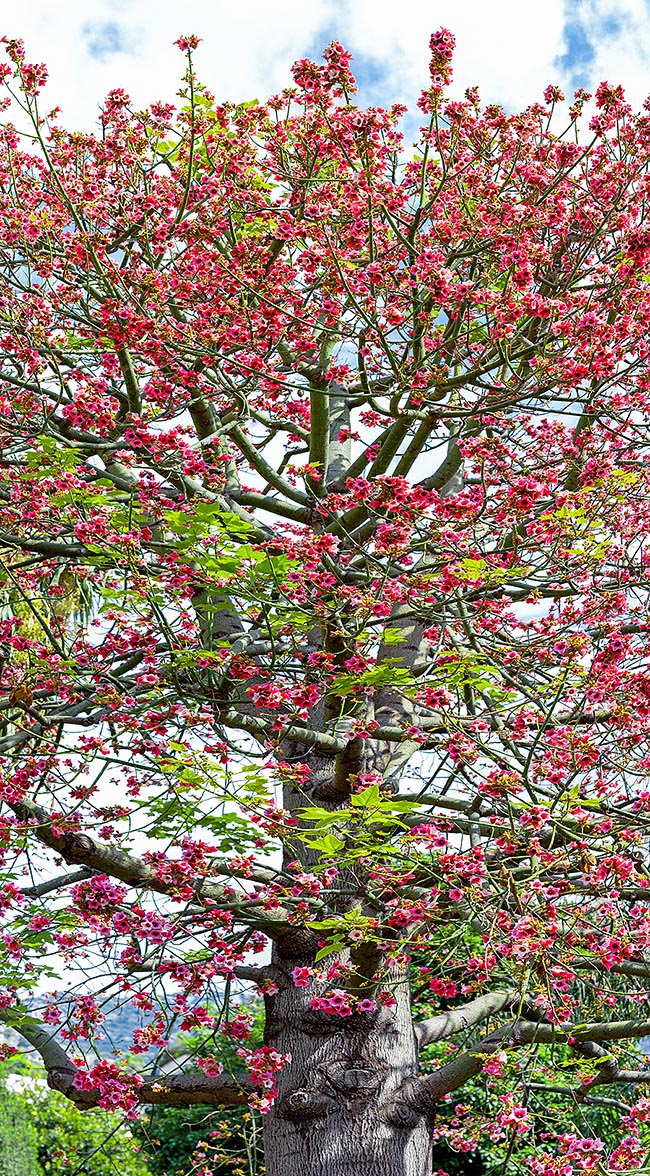
Brachychiton discolor is an eastern Australia tree reaching 35 m of height © Giuseppe Mazza
Brachychiton discolor F. Muell. (1858) is a species of the family Malvaceae, by Ferdinand Jacob Heinrich von Mueller (1825-1896) in its opus “Fragmenta Phtyographiae Australiae, Melbourne” (Fragm. Vol. 1:1, 1858).
It is a species native to eastern Australia from Paterson, New South Wales, to Mackay, Queensland, and at Cape York and is found in the dry rainforest, from the sea level up to 1000 m of altitude.
Thanks to its vast distribution and the absence of serious threats, it has been inserted, in 2018, in the category of minimal risk (LC, Least Concern) of the IUCN Red List of the endangered species.
Brachychiton comes from the Greek “βραχύς” (brachys), short and “χῐτών” (chiton), tunic or covering, alluding to the bristles covering the seeds like a short tunic inside the fruits.
The specific epithet discolor comes from the Latin “discolor, -oris”, of different colours, due to the contrast between the upper pagina and the lower one of the leaves.
The most common names are: Lacebark tree and Pink flame tree.
Brachychiton discolor is a 15 to 35 m tall tree, deciduous (or semi-deciduous) with straight and bottle-shaped cylindrical trunk, and ample and messy pyramidal crown.
The bark, initially smooth and greenish, with age gets irregularly vertically fissured, almost similar to a lace (hence the common name), of greyish or brown colour.
The new twigs are tomentose, but during their growth they become sparsely hairy or glabrous.
The leaves, simple and alternate, have a cordate base and margin with 5(-7) triangular lobes, obtuse or acute and measure 10-20 x 10-20 cm, with palmate veins, more prominent in the lower pagina.
They are green on the upper pagina and white-tomentose in the lower one, but may become reddish or bronze during periods of stress or of drought.
The petiole is pubescent, 5-12 cm long, with deciduous stipules, triangular-lanceolate, 6-12 (17) mm long covered by short starred hairs.
The inflorescences, covered by brown hair, are axillary, paniculate, with (3) 5-8 (10) flowers.
Brachychiton discolor is a monoecious species with unisexual flowers on the same individual. Usually the flowers are reddish outside and pink, of varying intensity) in the innermost part.
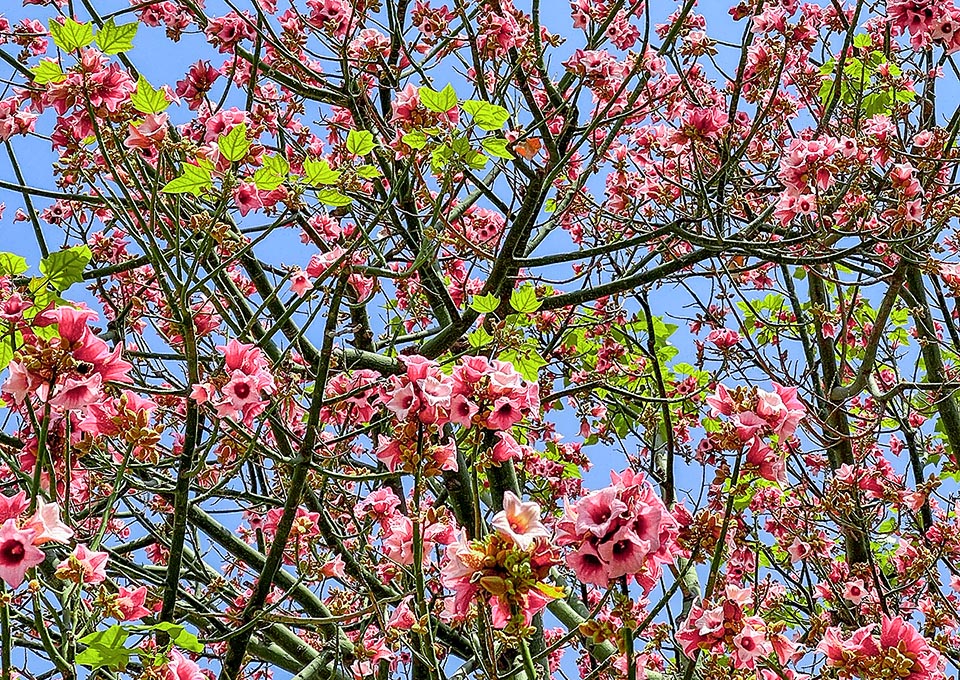
Due to its showy blooming is often present in gardens adapting to various types of soil, provided well drained, tolerating drought and temperatures just under zero © Giuseppe Mazza
The perianth is campanulate, 5(8) lobed, with a diameter of 50-60 cm and 3,5-4,2 cm long tube, narrower at the base, covered by a tomentum of starry hairs and papillae.
The sepals are thick and petaloid, covered on the lower part and on the tube with velvety hairs more or less evident on the buds. There are no petals.
The nectaries, located at the base of the tube, are 10 (-16), opposite to each lobe of the perianth, 1,6-2,2 mm long.
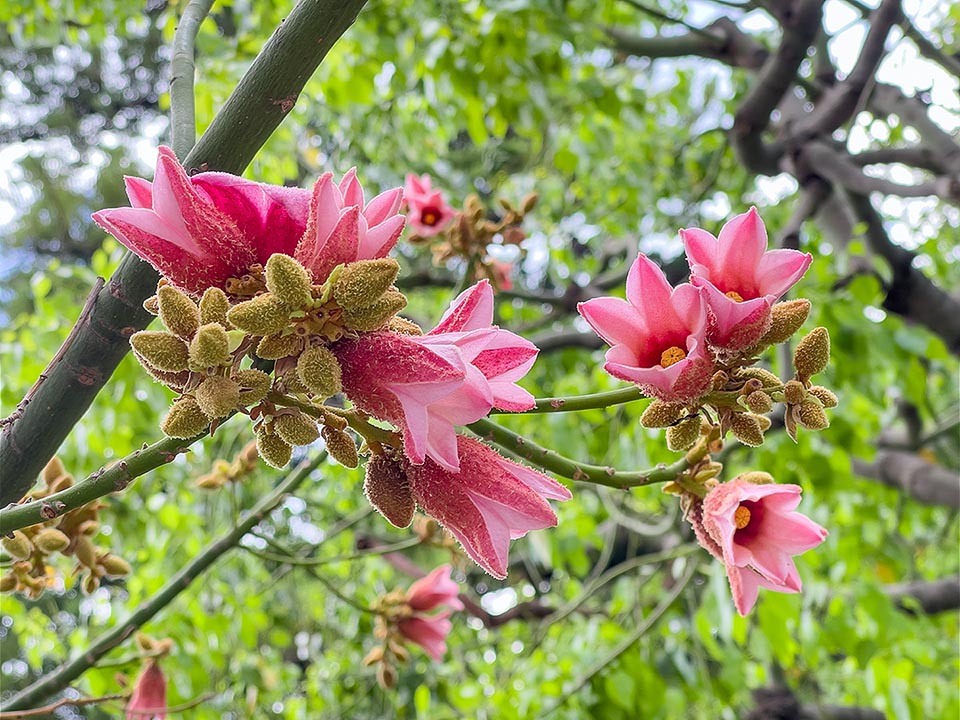
Brachychiton discolor is a monoecious species with unisexual flowers. The inflorescences, covered by brown hair, are axillary, paniculate, usually with 5-8 flowers © Giuseppe Mazza
The male flowers have 25-30 yellow, 2,6 mm long, anthers, staminal columns of about 18 mm and a regressed rudimentary ovary.
The female flowers have an ovary with 5 free carpels, covered by starry hairs, about 4,5-6 mm long. The styles are 3,5-5 mm long and the (2-3 mm) stigmas are ovoid, cream coloured.
At the base of the ovary are present rudimentary, aborted (staminoid) stamens, glabrous, up to 2 mm long, 25 or 30 in number.
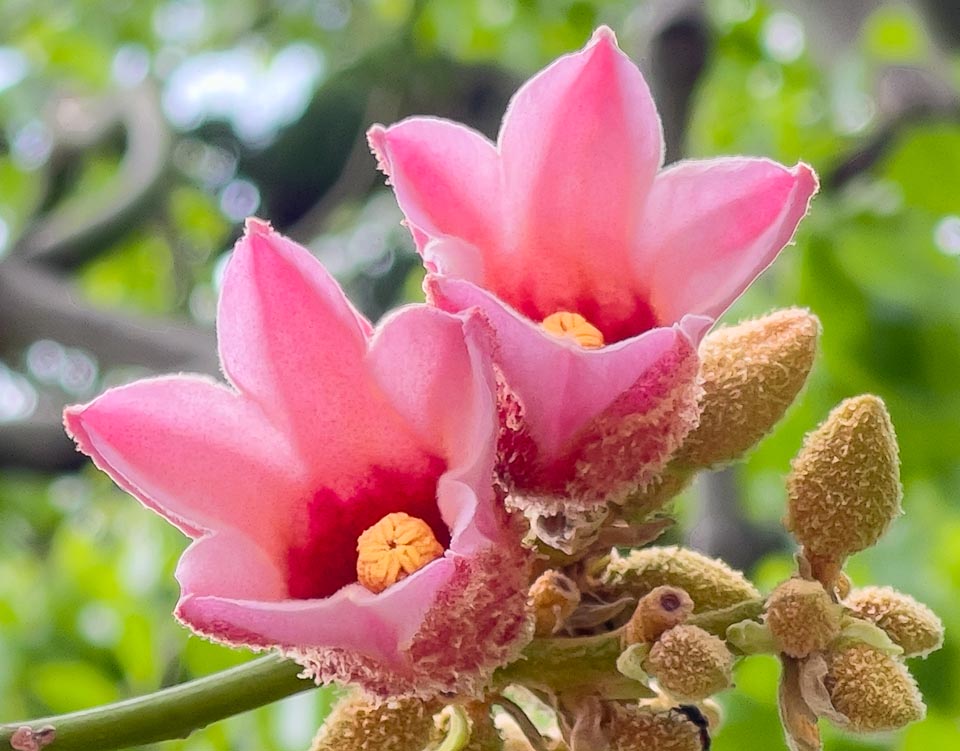
The male flowers have several yellow anthers surrounding the remains of an ovary regressed in the passage to unisexuality to avoid self-fertilization © Giuseppe Mazza
The blooming occurs, in the origin sites, from November to February, that is in late spring and early summer, when the tree is almost bare. The pollination, thanks to the shape of the flowers and the abundant nectar, is done by the birds and also by insects (bees).
Each carpel forms a woody fruit shaped like a small boat.
It is an ellipsoidal follicle, rostrated, 10-13 (20) x 3,5-4,5 cm, densely tomentose and containing 30-50 ovoid or ellipsoidal seeds, wrinkly, 9-10 x 5-7 mm.
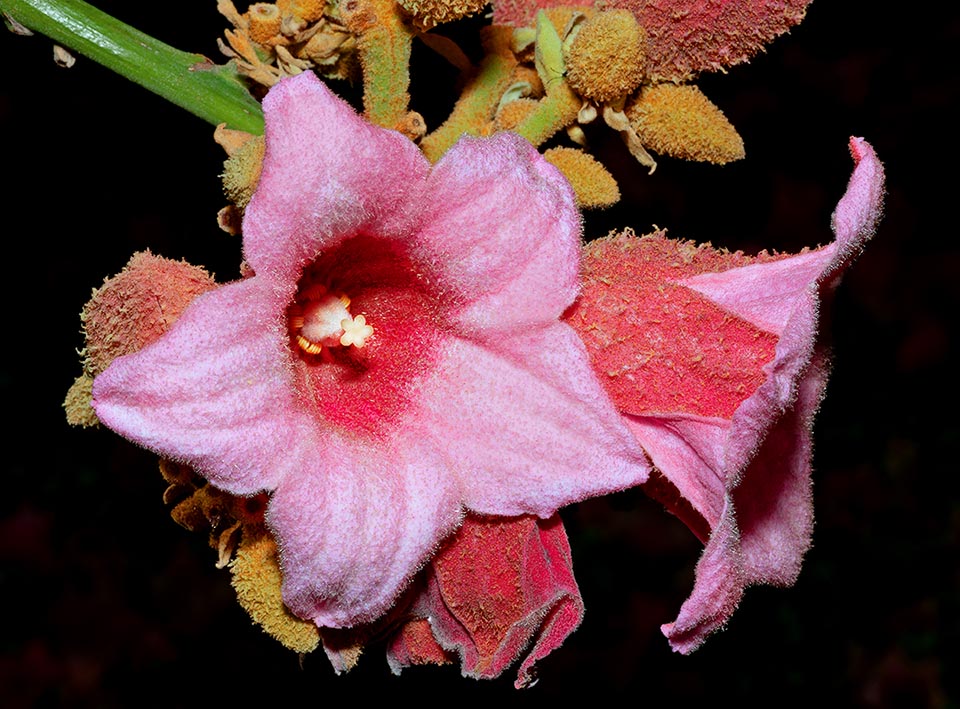
Female flowers have a 5 free carpels ovary, surmounted by cream-coloured stigmas. At the ovary base stand rudimentary stamens, aborted (staminoids) © Giuseppe Mazza
In the northern hemisphere the fruit ripens between December and July.
The dehiscence happens through one only longitudinal fissure (that is the suture line of the carpel) to display the rows of seeds, initially yellow, of brown colour when ripe.
The seeds keep quite well at room temperature and it has been observed that after 15 years their germination rate is 54%.
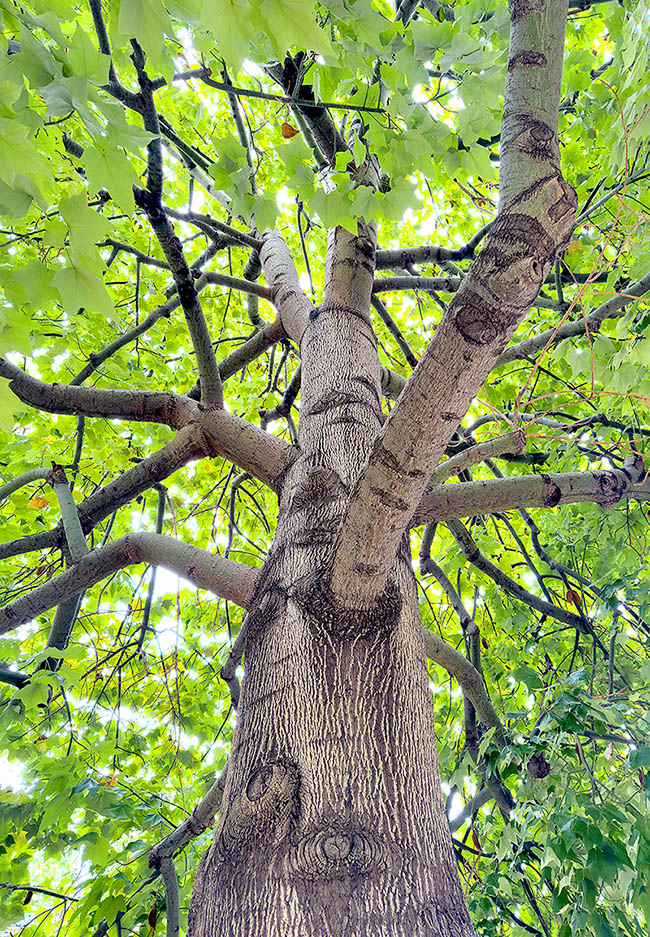
The leaves, locally used for dermatitis, are green on the upper pagina and pale-tomentose on the lower one © Giuseppe Mazza
The Australian natives utilize the wood for realizing objects (shields) but it is not of good quality.
Conversely, the seeds, edible, are locally used for preparing, after roasting, a particular drink, similar to coffee, but with a delicious hazelnut flavour.
In the origin sites, the leaves are appreciated by the cattle and are utilized as forage during the summer drought.
They are employed also in the traditional medicine for itching, dermatitis and other skin diseases.
With the aim of checking on a scientific basis the popular medicinal use of this plant, a study has been done to evaluate the anti-inflammatory and anti-allergic activities of the leaves of this plant.
The tested extracts have shown absence of cytotoxicity on tumor cells (breast and lung cancer) and in them has been isolated the scopoletin, that has anti-allergic effects and also a light anti-inflammatory activity.
Recent studies on chromatographic and spectroscopic methods of extracts of leaves at the 70% of methanol/water have led to the isolation and identification of three phenolic acids (trans-p-coumaric acid, trans-p-coumaric-O-glucoside acid, chlorogenic acid) and of one flavonoid glycoside (rutin) having antioxidant activities and capable of reducing the oxidative stress and the inflammatory reactions.
They are bioactive compounds that could be useful for human health and could find employment in appropriate pharmaceutical preparations.
Outside its natural areas, Brachychiton discolor is a species cultivated as an ornamental plant, much appreciated in gardens, parks and urban landscapes, where, due to its dramatic blooming, adds elegance and beauty. Moreover, thanks to its very compact root system, it is possible to utilize it as a road tree, but only where the space allows.
As a matter of fact, it is not a plant suitable for narrow alleys or for reduced spaces as it tends to raise the ground around the stem. Furthermore, the hairs on the flowers and its fruits are somewhat irritating and are not to be touched with the hands.
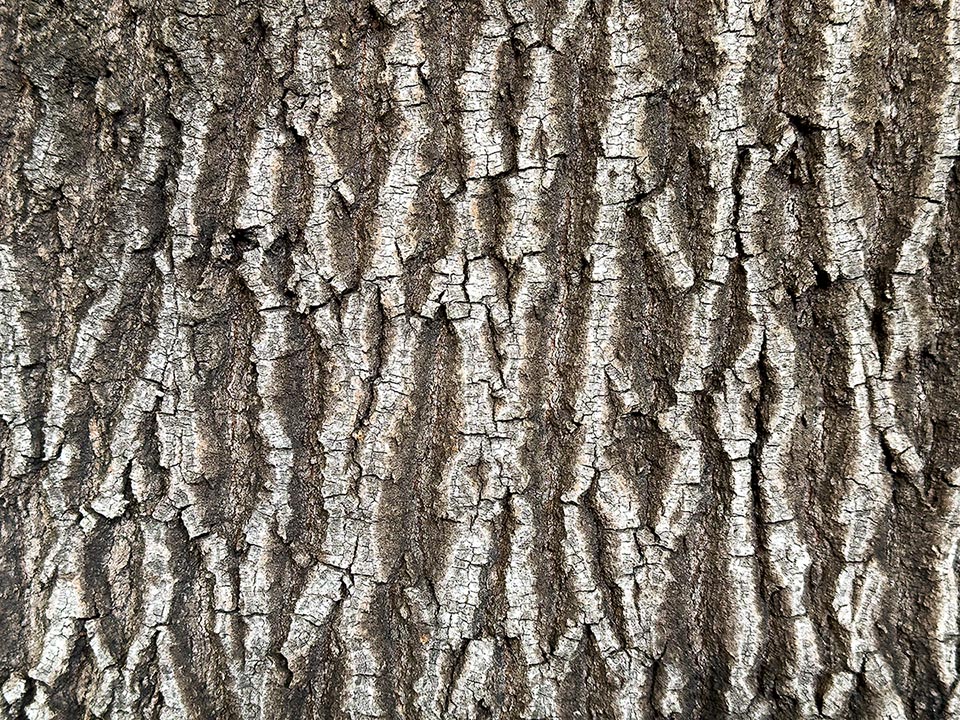
The initially smooth and greenish bark, while ageing becomes irregularly fissured vertically, like a lace, hence the name of Lacebark tree © Giuseppe Mazza
In Australia it’s very appreciated for furnishing shelter and shade in drought areas. The species has been introduced in the USA , for the first time, in 1923 by the Bureau of Plant Industry, of the USA Agriculture Department.
Achille Terracciano (1861-1917), Italian explorer and botanist, in a treatise concerning the genus Brachychiton, published by the Bulletin of Royal Botanical Garden of Palermo of 1897, reports that the species was already present and flowering in that Garden.
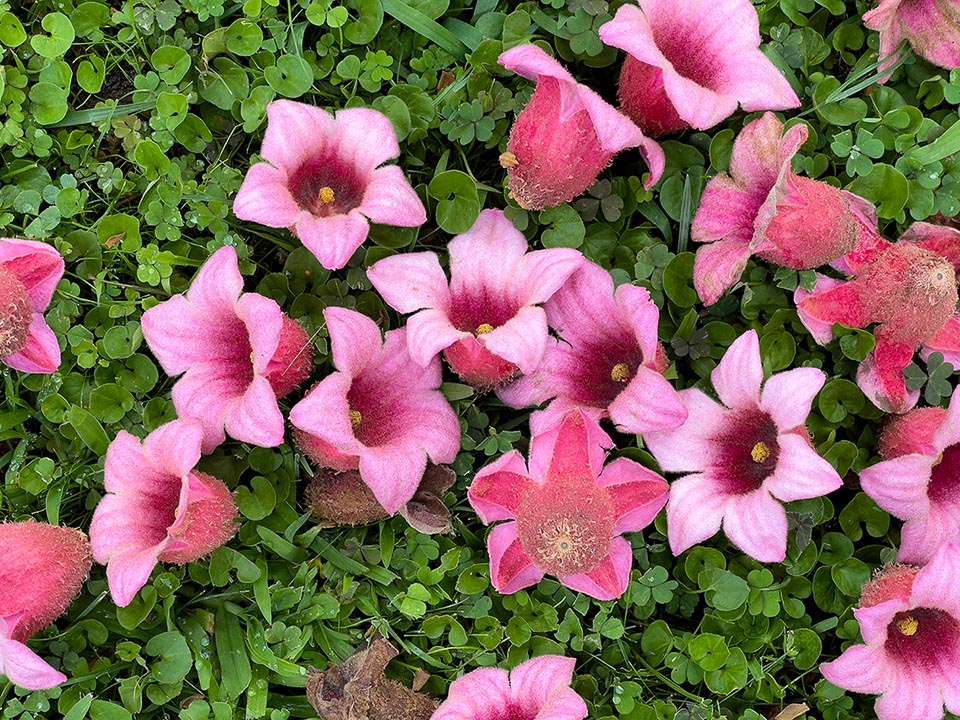
In the gardens we often note the presence of this majestic species for the carpet of flowers fallen on the soil that are so discovered, closely, in their surprising beauty © Giuseppe Mazza
The plant multiplies by seed and the germination is easier when the seeds are previously soaked in warm water for about 12-24 hours.
It is suggested to use a pot with fine loam and with the addition of perlite or of sand in order to lighten the substratum. The use of garden soil or of acidic soil is not recommended.
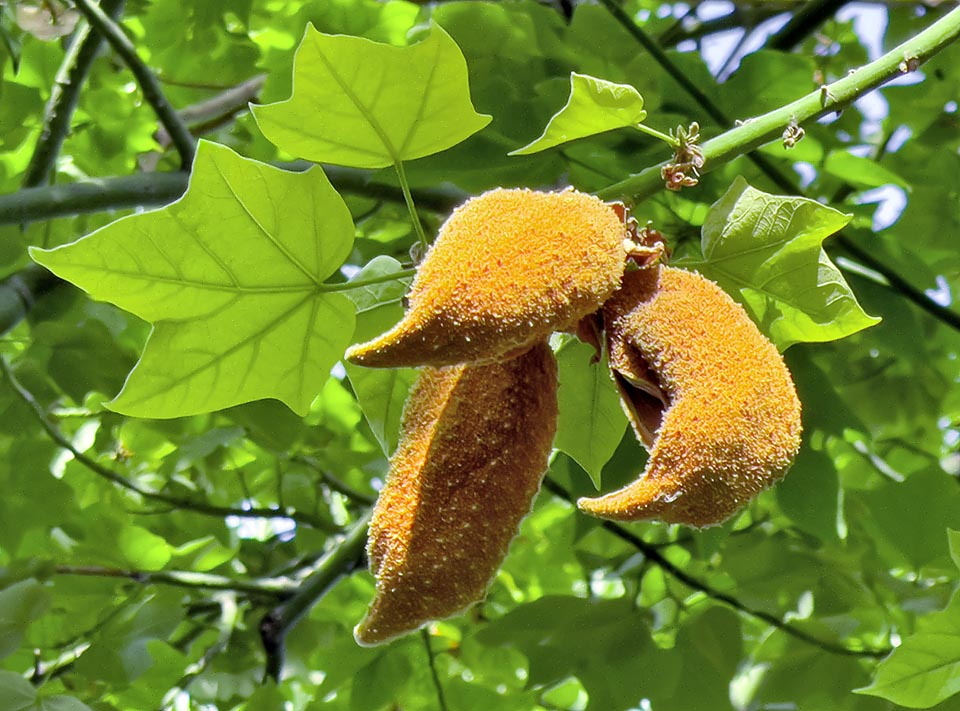
The unusual woody fruits shaped like a small boat, contain 30-50 ovoid seeds, wrinkled and brown when ready, that get out when ripe from one only longitudinal fissure © Giuseppe Mazza
The repottings, two per year, are to be done in spring and in autumn, increasing gradually the size of the pot and adapting the same to the length of the roots.
The increase of the size of the pot is useful because a new substratum is made without adding any fertilizer that might burn the delicate roots.
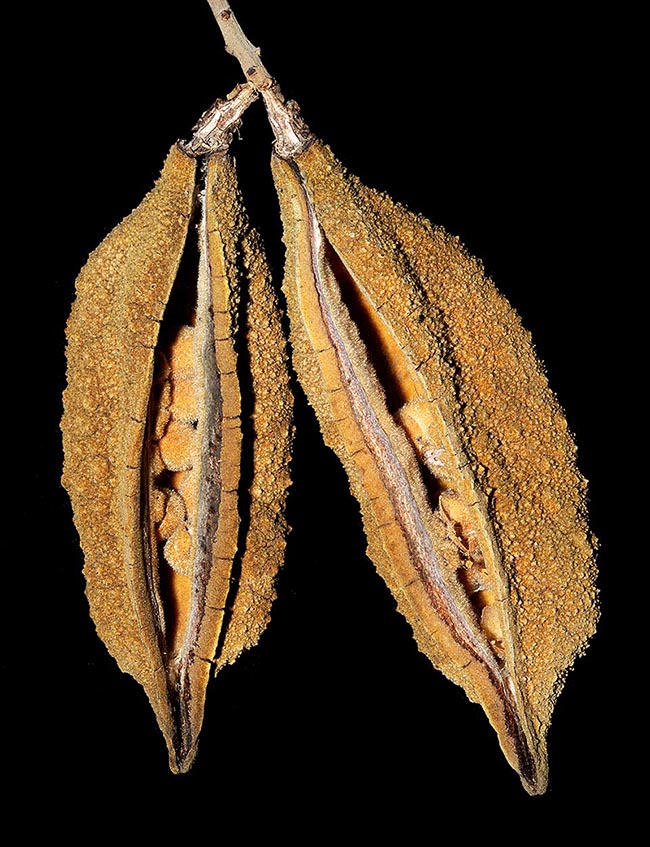
Brachychiton discolor roasted seeds are locally used to prepare a coffee-like drink with a delicious taste of hazelnut © Giuseppe Mazza
The waterings must be abundant but it’s good practice to wait for the substratum to dry up a little before giving more water.
After the first year in pot can be done the transplantation into the open ground and it is suggested to effect this in late spring.
This plant adapts to different types of soil, provided well drained, and appreciates sunny exposures or light shade, as it tolerates drought and even little below temperatures.
Containing the plant with the prunings must be avoided as these could cause damage to it and in case of attack by parasites (usually aphids) to spray, particularly on the lower pagina of the leaves, liquid black soap diluted in water.
This practice is to be repeated several times a few days later.
This species forms natural hybrids with Brachychiton populneus (Schott & Endl.) R.Br., with Brachychiton bidwillii Hook., 1859 and with Brachychiton acerifolius (A.Cunn. ex G.Don) F.Muell.
We mention:
Brachychiton populneus × discolor ‘Griffiths Pink’ (B. populneus × B. discolor )
Brachychiton × vinicolor (B. acerifolius × B. discolor)
Brachychiton × vinicolor ‘Clarabelle’ (B. acerifolius × B. discolor)
Brachychiton × excellens (B. bidwillii × B. discolor)
Synonyms: Brachychiton paradoxus subsp. discolor (F.Muell.) A.Terracc.; Brachychiton paradoxus var. discolor (F.Muell.) A.Terracc.; Clompanus discolor (F.Muell.) Kuntze; Sterculia discolor (F.Muell.) Benth. ; Brachychiton luridus C.Moore ex F.Muell.; Brachychiton paradoxus subsp. luridus (C.Moore ex F.Muell.) A.Terracc.; Brachychiton paradoxus var. luridus (C.Moore ex F.Muell.) A.Terracc.; Clompanus lurida (F.Muell. ex Benth.) Kuntze; Sterculia lurida F.Muell. ex Benth.
→ To appreciate the biodiversity within the MALVACEAE family please click here.
